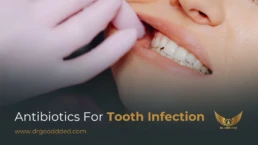Antibiotics for ear infection are medicines doctors give when bacteria cause your ear pain. Most middle ear infections heal without drugs. You need antibiotics when a doctor finds clear bacterial signs or when symptoms are severe. Amoxicillin is the usual first choice. Use the right drug, dose, and length to stop the infection and avoid resistance.
Table of Contents
ToggleWhat Antibiotic for Ear Infection Is Prescribed?
When you see a doctor, they ask about your symptoms. They check your ear with an otoscope. If the eardrum looks red, bulging, or if pus drains, the doctor may start antibiotics for an ear infection.
If you are very young, very sick, or have a high fever, the doctor treats you right away. If symptoms are mild, the doctor may watch for 48 to 72 hours before prescribing. That helps avoid unnecessary antibiotics.
How antibiotics fight bacterial ear infections
Antibiotics kill or stop bacteria that live in the middle ear fluid. This lowers pain and fever. For outer ear infections, medicine in drops reaches the infection directly. For middle ear infections, pills travel in the blood to the middle ear. You must take the full dose the doctor ordered. This helps clear the infection and reduce resistance.
Signs your ear infection needs antibiotics
You need antibiotics if you have:
- Severe ear pain.
- High fever.
- Pus draining from the ear.
- Worsening symptoms after a few days.
- Age under six months.
These signs show a likely bacterial cause. If you have any, call your doctor right away.
Why viral infections don’t respond to antibiotics
Viruses cause many ear problems. Antibiotics do not kill viruses. Giving antibiotics for a virus can cause side effects. It also helps resistant bacteria grow. Doctors try to tell viral and bacterial cases apart before using antibiotics. If the cause looks viral, you get pain relief and watchful waiting.
How long do antibiotics take to work for ear infections
You should feel better in 48 to 72 hours after starting the right antibiotic. If pain or fever stays the same or gets worse after three days, call your doctor. Finish the full course the doctor prescribes.
Stopping early can leave bacteria alive and cause resistance. Recent guidelines support shorter courses for older children and adults in many cases.
Best Antibiotic for Ear Infection: Top Prescriptions for Adults and Children
When the doctor decides to treat, they pick a drug based on age, allergy, and severity. The goal is to choose the best antibiotic for an ear infection for your situation. Doctors prefer narrow drugs when possible. This protects your gut and limits resistance.
Amoxicillin — The First-Line Treatment For Bacterial Otitis Media
Amoxicillin is the first choice for most middle ear infections. It reaches the middle ear well. For children, doctors often use a higher dose. The dose aims to kill common germs that cause ear infections. If you are allergic to penicillin, you need a different class of drug. Amoxicillin usually works fast and has a good safety record.
Augmentin (Amoxicillin-Clavulanate) For Resistant Infections
If a standard amoxicillin dose fails or bacteria make an enzyme that destroys amoxicillin, doctors may use amoxicillin-clavulanate. This drug treats tougher germs. It causes more stomach upset in some people. Doctors reserve it for resistant or severe cases. When you take it, follow the exact dose and schedule.
Cefdinir, Cefuroxime, And Alternatives For Penicillin-Allergic Patients
If you have a mild penicillin allergy, a cephalosporin like cefdinir may work. If the allergy is severe, a macrolide such as azithromycin may be safer. The doctor checks your allergy history before choosing. Some alternatives may not work as well for certain germs. Use them only when needed.
Azithromycin Or Clarithromycin For Broader Bacterial Coverage
Macrolides can treat ear infections in patients allergic to penicillin. Azithromycin is often given as a short course. Resistance to macrolides varies by region. Doctors use them when other choices are not safe. Always tell your clinician about past drug reactions.
Ear Infection Antibiotics List For Adults And Pediatric Use
Common prescriptions include: amoxicillin, amoxicillin-clavulanate, cefdinir, cefuroxime, azithromycin, and, in select cases, doxycycline or trimethoprim-sulfamethoxazole for adults. Dosage and length depend on age and severity. If you want a clear ear infection antibiotics list for adults, ask your provider for a written plan. This helps you follow the dose and duration exactly.
Antibiotic Ear Drops for Outer Ear Infection
Topical ear drops work best for infections of the ear canal. They act where the germs live. You can use drops when the eardrum is intact. Some drops are safe even with a small hole in the eardrum. Use drops as your provider shows you.
Ciprofloxacin And Dexamethasone Ear Drops For Swimmer’s Ear
A common prescription is ciprofloxacin with dexamethasone. The antibiotic fights bacteria. The steroid lowers swelling and pain. Use the drops for the full course. You should feel relief in a few days. If not, call your clinician.
Ofloxacin Drops: How To Use Them Correctly
Tilt your head. Put the prescribed number of drops in the ear. Keep the ear facing up for one minute. Follow this routine twice daily or as told. Ofloxacin works for many outer ear infections. It is safe in some cases where the eardrum is damaged. Ask before using any drop near a known perforation.
When To Combine Ear Drops With Oral Antibiotics
If the infection spreads beyond the ear canal or you have a fever, your doctor may add an oral antibiotic. For a local ear canal infection, drops alone usually work. Your provider decides based on how you look and respond.
Side Effects And Safety Of Topical Antibiotics
Drops can irritate the skin in the ear canal. Rarely, they cause allergic reactions. Do not use drops meant for intact eardrums if you have a hole, unless the doctor approves. If you get new pain, swelling, or hearing loss, stop the drops and call your clinician.
Antibiotics for Ear Piercing Infection
Ear piercing infections are different from ear canal or middle ear infections. These happen on the skin or cartilage around the piercing site. If ignored, they can spread fast or leave scars. Using the right antibiotics for an ear infection caused by piercings helps you heal quickly and avoid complications.
When an Ear Piercing Infection Requires Antibiotics
Minor redness, swelling, or crusting after a new piercing is normal. But if the pain worsens, thick yellow pus appears, or the area feels hot, the infection is bacterial.
You need antibiotics when:
- The swelling spreads beyond the piercing area.
- The pain increases despite cleaning.
- Fever or chills appear.
- You notice tissue breakdown or dark scabs.
These signs mean the bacteria are spreading under the skin, which may need oral antibiotics for an ear infection or even drainage if pus forms.
Topical vs. Oral Antibiotics for Piercing Infections
Mild infections respond well to topical antibiotic creams, such as mupirocin. Apply a thin layer after gentle cleaning with saline.
If redness and pain spread, doctors may prescribe oral antibiotics like amoxicillin-clavulanate or clindamycin. Topical treatment works only on surface infections; deeper ones need pills.
How to Clean and Care for an Infected Ear Piercing
Good cleaning habits are vital for recovery:
- Wash your hands before touching the area.
- Clean gently twice a day with warm saline water.
- Avoid alcohol or hydrogen peroxide; they slow healing.
- Keep your jewelry in unless the doctor says otherwise.
- Use a cotton swab, not your fingers, for ointment application.
Proper cleaning prevents bacteria from growing and helps antibiotics do their job.
When to Seek Medical Help for Severe Infection
See a doctor if swelling grows, pain worsens, or you feel unwell. For cartilage piercings (upper ear), infection can spread quickly. Doctors might need to drain pus or change your antibiotic. Untreated cartilage infections can deform the ear permanently, so never delay care.
Using antibiotics for ear piercing infection correctly makes a big difference. Follow your doctor’s advice and complete the full course.
Ear Infection Antibiotics List for Adults and Age-Based Dosing
Finding the right ear infection antibiotics list for adults helps you understand treatment better. Doctors choose based on age, infection type, and drug resistance.
| Antibiotic | Common Adult Dose | When It’s Used |
| Amoxicillin | 500 mg every 8 hrs or 875 mg every 12 hrs | First choice for middle ear infections |
| Amoxicillin-Clavulanate | 875/125 mg every 12 hrs | Used for resistant or severe infections |
| Cefdinir | 300 mg every 12 hrs | For mild penicillin allergy |
| Cefuroxime | 250–500 mg every 12 hrs | For moderate infections |
| Azithromycin | 500 mg on day 1, then 250 mg daily for 4 days | For true penicillin allergy |
| Ofloxacin (drops) | 5–10 drops twice daily | For outer ear infection |
Common Antibiotics Prescribed for Adult Ear Infections
Doctors usually start with amoxicillin, unless resistance is common locally. If it fails, they move to Augmentin (amoxicillin-clavulanate). People allergic to penicillin often use cefdinir, cefuroxime, or azithromycin.
Antibiotic selection depends on:
- Your age.
- Infection severity.
- Medical history.
- Past antibiotic use.
These factors decide which antibiotics for ear infection will work best for you.
Duration and Dosage Based on Infection Severity
For mild ear infections, a 5–7 day course is often enough. For severe or recurrent cases, 10 days may be needed. Children under two years usually require a full 10-day course.
Always follow the exact dose your doctor prescribes. Missing doses weaken the drug’s effect and allow bacteria to survive.
How Antibiotic Resistance Develops from Incomplete Treatment
Stopping early or skipping doses allows bacteria to survive. These resistant bacteria multiply and can make future infections harder to treat. Completing the full antibiotic course prevents this problem and protects others around you.
Signs Your Antibiotic Is Working (And When to Return to Your Doctor)
When treatment works:
- Pain and fever drop within 48–72 hours.
- Hearing improves.
- Swelling and redness go away.
If symptoms persist or worsen, see your doctor again. They might switch you to a stronger or different best antibiotic for ear infection based on culture results.
Understanding Outer, Middle, and Inner Ear Infections
Ear infections differ based on which part of the ear is affected. Each area requires different care and sometimes different antibiotics for an ear infection.
Outer Ear (Otitis Externa): When Ear Drops Work Best
This infection affects the ear canal. It often happens from trapped water, called “swimmer’s ear.”
Symptoms include:
- Itchy, painful ear canal.
- Yellow discharge.
- Tenderness when pulling the ear.
For outer ear infections, antibiotic ear drops for outer ear infection, such as ciprofloxacin or ofloxacin, are most effective. Keep your ear dry and avoid inserting objects into it.
Middle Ear (Otitis Media): Treated with Oral Antibiotics
This infection occurs behind the eardrum. It’s common in children due to their shorter eustachian tubes (small passage between the ear and throat).
Common bacteria: Streptococcus pneumoniae and Haemophilus influenzae. Doctors often prescribe amoxicillin or amoxicillin-clavulanate. Painkillers like ibuprofen can relieve pain while antibiotics work.
Inner Ear (Labyrinthitis): When Antibiotics Aren’t Effective
This infection affects the deep part of the ear responsible for balance. Most inner ear infections are viral, not bacterial. Antibiotics don’t help unless tests confirm bacteria. Treatment focuses on:
- Rest.
- Hydration.
- Medicines to reduce dizziness and nausea.
If symptoms persist, doctors may refer you to an ear, nose, and throat (ENT) specialist.
Chronic and Recurrent Ear Infections — Prevention Tips
If ear infections keep coming back, you can reduce the risk by:
- Avoiding smoking or secondhand smoke.
- Keeping ears dry after swimming.
- Managing allergies.
- Getting flu and pneumococcal vaccines.
- Using ear tubes in severe, recurring cases (tiny tubes help air flow and prevent fluid buildup).
Preventing repeated infections saves you from repeated antibiotic use and resistance.
Risks and Side Effects of Antibiotics for Ear Infection
Every antibiotic can cause side effects, though most are mild. Knowing what to watch for helps you stay safe.
Common Side Effects: Nausea, Diarrhea, Dizziness
The most frequent side effects include:
- Mild stomach upset.
- Loose stools.
- Temporary dizziness.
Take antibiotics with food if advised. Drink plenty of water to prevent dehydration from diarrhea.
Allergic Reactions to Penicillin and Related Drugs
If you develop:
- Rash or hives.
- Itching or swelling.
- Trouble breathing.
Stop the medicine and seek medical help immediately. Doctors can confirm allergies with skin tests and choose the best antibiotic for ear infection that’s safe for you.
Safe Over-the-Counter Pain Relief During Antibiotic Therapy
While waiting for the antibiotics for the ear infection to work, pain relief is key. You can use:
- Acetaminophen (Tylenol) for pain and fever.
- Ibuprofen (Advil) for pain and inflammation.
Avoid aspirin in children due to Reye’s syndrome risk.
When to Stop Antibiotics and Call Your Doctor
Stop antibiotics only if:
- You get a severe allergic reaction.
- You have strong diarrhea with blood or mucus.
- You develop swelling or shortness of breath.
Otherwise, always finish your antibiotic course to ensure complete recovery.
What to Do If Antibiotics Don’t Work for Ear Infection
Sometimes, even the right antibiotics for ear infection may fail due to resistant bacteria or incorrect dosing.
How to Identify Resistant Bacterial Infections
Signs include:
- No improvement after 3 days of treatment.
- Symptoms that return soon after finishing antibiotics.
- Worsening fever or discharge.
Your doctor might do a culture test to identify the bacteria and switch you to another best antibiotic for ear infection, like cefuroxime or Augmentin.
Non-Antibiotic Treatments (Ear Tubes, Drainage, or Surgery)
Chronic infections may need:
- Ear tubes (ventilation tubes) to drain trapped fluid.
- Minor surgery to clean infected tissue.
- Pain-relief ear drops to ease discomfort while the infection heals.
These procedures are safe and often done under local anesthesia.
Home Remedies for Symptom Relief While Antibiotics Act
You can ease pain and swelling with:
- Warm compress over the affected ear.
- Gentle neck exercises to improve ear drainage.
- Rest and hydration.
Avoid inserting oil, cotton buds, or homemade mixtures inside your ear. They can worsen the infection.
Role of Probiotics in Restoring Gut Balance After Antibiotic Use
Antibiotics can upset your gut bacteria. Probiotics (good bacteria found in yogurt and supplements) help restore balance. They reduce diarrhea and improve digestion during antibiotic therapy. Ask your doctor which type is safe for your age.
FAQ
What’s the best antibiotic for an ear infection in adults?
Doctors often choose amoxicillin first. If resistance or allergies exist, they switch to amoxicillin-clavulanate or cefdinir for effective results.
Can antibiotics treat viral or fungal ear infections?
No. Antibiotics for ear infection only work on bacteria. Viral and fungal ear infections need different medicines or antifungal drops.
How long should I take antibiotics for an ear infection?
Most people take them for 5–10 days. The exact duration depends on your age, infection severity, and the drug type.
Can I reuse leftover antibiotics for new ear pain?
Never. Leftover pills may not match the infection type or dose needed. Always visit a doctor before taking any antibiotic.
Do antibiotics help with ear fluid or muffled hearing?
If bacteria cause the fluid, yes. If not, antibiotics won’t help. Persistent fluid may need an ENT check or ear tube insertion.
Which antibiotic ear drops for outer ear infection work best?
Ciprofloxacin or ofloxacin drops work very well. Follow your doctor’s dosage carefully and finish the full course to prevent recurrence.
How do I know if antibiotics are working?
Pain and fever usually reduce within three days. If symptoms stay the same or worsen, contact your healthcare provider for a review.

This article is medically reviewed by Dr. Nivedita Pandey, Senior Gastroenterologist and Hepatologist, ensuring accurate and reliable health information.
Dr. Nivedita Pandey is a U.S.-trained gastroenterologist specializing in pre and post-liver transplant care, as well as managing chronic gastrointestinal disorders. Known for her compassionate and patient-centered approach, Dr. Pandey is dedicated to delivering the highest quality of care to each patient.









